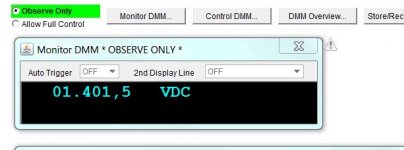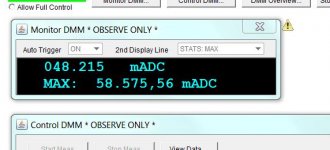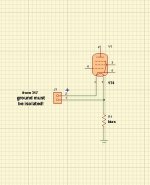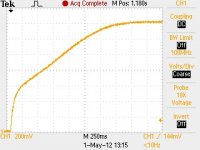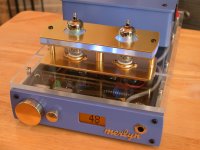I led the horse to water...... Sorry.I disagree. First, NS regulators work fine, if you want to go to LT that's your decision.
This simple circuit allows the current to build and not exceed the maximum current of the tube and then lock on the 1.4 volts that these filaments require. Electrons flow, I assure you.
I built this, listened to it for over a year, had others listen to it and compared it to other designs of my own along with other builders work. You, on the other hand, looked at a partial schematic.
I'm happy to have readers improve my designs. If you think you have send me the schematic, I will be happy to bread board it and try it.
For future reference, assumptions about my background, hype, silly you tube videos, "dark side" analogies, etc., etc. do nothing to impress me.
Rob
I've looked at the design and don't quite get it!!
You take a high level signal of approx +- 2v, attenuate it though a 100k pot so you can use a 1T4 biased at -0.4volts, grid leak 10M, then Trioded, running at B+ 67volts, pass it through some MHz Opamp, followed by another MHz unity gain Opamp Buffer.
From my understanding, get rid of the 1T4!!
I'm gonna get Backballed again, but I notice SY is a contributer in the same edition
Regards
John
Not +/- 2volts, the gain is set at ~20 db, the buffers have a specific purpose and the tube is what everyone loves about the sound of this amp. It's been prototyped without it, by the way.
Let me know if you "get it" when you listen to it.
Rob
From my understanding, the ground breaking design is a Kluged version of this:
http://www.audioamateur.com/media/gain_stage__rev3.pdf
With a sub-optimal 1T4 banged on front to give a 'Tube sound', then wrapped up in some 'esoteric' mumbo jumbo description
John
http://www.audioamateur.com/media/gain_stage__rev3.pdf
With a sub-optimal 1T4 banged on front to give a 'Tube sound', then wrapped up in some 'esoteric' mumbo jumbo description
John
From my understanding, the ground breaking design is a Kluged version of this:
http://www.audioamateur.com/media/gain_stage__rev3.pdf
With a sub-optimal 1T4 banged on front to give a 'Tube sound', then wrapped up in some 'esoteric' mumbo jumbo description
John
I don't know who "Kluged" is but that's my design!
It's called "Willow" from Dec. 2011 aX. It was an experimental design that I've since updated.
Last edited:
One of the advantages of the print magazine over this website is the letters to the editor have a higher standard.
Of course you did mention in the article the heritage of the current version.
I thought the May Audioxpress was perhaps the best since the change in ownership.
(BTY I sometime back bought a huge assortment of portable radio tubes, including 1T4's.)
Of course you did mention in the article the heritage of the current version.
I thought the May Audioxpress was perhaps the best since the change in ownership.
(BTY I sometime back bought a huge assortment of portable radio tubes, including 1T4's.)
I thought the May Audioxpress was perhaps the best since the change in ownership.
Even though it has my picture in it? No accounting for taste, I suppose.
Even though it has my picture in it? No accounting for taste, I suppose.
Well that was a minor drawback, but the really big advantage was none of my stuff and they removed my name from the "Frequent Contributors."
Even though it has my picture in it? No accounting for taste, I suppose.
Actually I think you had some valuable things to say and I like the fact that your experimental direction is very much different from mine. I always like to think there is a point where these differences meet and something new arises.
My next article is in a completely different direction also, it's a fully digitally uC generated analog pot using no carbon in the line. Manipulating just 12 resistors you get 128 detents plus balance. No contacts or abrasive connection to wear out. What you put in you get out, just at a different level. I think a lot of people will like to experiment with the design when it comes out. It's in the Merlyn amp and a 6SN7 line stage I built before Merlyn.
I'm interested in what Jan Didden thinks of it as he had some interest when it was in the prototyping stage.
Rob
One of the advantages of the print magazine over this website is the letters to the editor have a higher standard.
Of course you did mention in the article the heritage of the current version.
I thought the May Audioxpress was perhaps the best since the change in ownership.
(BTY I sometime back bought a huge assortment of portable radio tubes, including 1T4's.)
Willow has a lot of potential, i don't know how many people modded it although I did get good interest in the design. It needs some changes and updates if anyone is building it though. It's an interesting sound, pretty musical but drier than Merlyn but then Merlyn is my 'baby'. Just for fun I pushed a 6SN7 through the output stage to hear the difference. It sounds good but I like the definition of the 1T4 more believe it or not. I think when people get away from any prejudices of the diminutive 1T4 they will be delightfully surprised. In fact I almost gave up on it. I built a protytype about two or so years ago and got away from it, then I walked by the amp one day, flipped it on and listened to it with a smile.
If you have a couple of 1T4 (DF91) Mullards that would be special! I'm running Mullards now with a couple of hundred hours of break in and I like the sound.
I came from the era of push pull, the more power the better. I give a lot of credit to the ears that heard the 300B's and thought this really sounds good because they had to put the biases (no pun intended) of PP big power aside and really listen with an open mind.
Rob
Last edited:
Merlyn Specifics
Response to questions about Merlyn:
I will address the filament supply first.
After several configurations and SPICE testing I chose the 317 supply for its simplicity, availability, cost and ease of use.
Each component was selected with a specific function. The 100 ohm resistor serves to buffer a low impedance load on the input diodes and the transformer. This allows an inexpensive transformer to be used. The 100 ohm resistor also acts as a ballast, slowly charging the 10,000 uF capacitor.
The image from the Tektronix scope shows the gradual rise to the 1.4 volts the tubes work at. Two 317 are used thus allowing each tube to controlled and regulated independently of the other. The LM317L in the TO-92 case is a good regulator, there are better regulators and you can use one if you like but I question the final result as better sound wise. The 317 has an RMS output noise of .003 % and a regulation of ~.1%. An LM217 will give you slightly better parameters and is a direct replacement if you feel you need better regulation.
The rise of the filament voltage takes about 2 seconds as can be seen on the Tek scope display. The voltage regulation on the Agilent 34410A shows the voltage to be 1.4015 volts and the maximum current from turn on to be 58.575 ma. Settling to 48 ma. With the tubes at 1.4 volts. Also remember that these are battery tubes and such they are designed to work on DC, but batteries are not ideal. The problem is that the RCA manual lists the optimum filament voltage at 1.4 volts. (Insertion loss from three terminal regualtors is 1.2 thus a 1.4 volt output voltage requires a low value adjustment resistor (30 ohms), use a 1 percent resistor here.)
Single cell batteries are 1.55 volts new. I could have designed a supply around the batteries but I did not feel it warranted the complexity when this supply works so well. While I did not bias the filaments I have included a basic scheme for those of you who wish to.
The 5002 is a high speed buffer >1300v/uS that acts as transconductance devices. You can omit the 5002 if you do not use phones. The THS4631 is an interesting device, while it is an opamp it has very high speed >1000 V/uS and works as a buffer, but it also can be used as a gain device. I have used it in both configurations in different circuits. You can not simply output the tubes to the 5002 and omit the 4631. The 5002 will self bias to several volts. You can bias the 5002 with a 100k resistor coming off the tube. The .47 uf capacitor will give a satisfactory output response. (1/2*PI*RC)
There will be some loading with the 33K plate output resistance which I like to keep at a 1/10 ratio. You can see my bias scheme on the "Willow" amp which is apparently around the board here. It is also in the Dec. 2011 issue of aX.
The bias scheme places a high (~470k) input impedance (higher than the THS4631 in unity gain). The downside of that bias scheme is that it could introduce power supply noise into the input. It wasn't bad but with phones you might want to use the THS4631 which, if I remember puts about 100 to 150k load impedance on the input dependent on device gain. Incidentally I started using the THS4631 after "Willow" was designed. When you see a design in a magazine chances are the author is well past it and on to other things, at least I am.
One other note about the buffer and opamp. I find both neutral to dry, the sound of this amplifier then takes on the characteristics of the tube which fits the sound I and the other individuals who have heard it like. You can experiment with other buffer arrangements and different tubes to contour the sound you prefer but I would suggest before you do this that you audition the 1T4. Also keep in mind this amp takes at least 50 hours to break in.
I hope this helps with some of your questions.
Rob
Scope Tektronix 2012B
Meter Agilent 34410A
Response to questions about Merlyn:
I will address the filament supply first.
After several configurations and SPICE testing I chose the 317 supply for its simplicity, availability, cost and ease of use.
Each component was selected with a specific function. The 100 ohm resistor serves to buffer a low impedance load on the input diodes and the transformer. This allows an inexpensive transformer to be used. The 100 ohm resistor also acts as a ballast, slowly charging the 10,000 uF capacitor.
The image from the Tektronix scope shows the gradual rise to the 1.4 volts the tubes work at. Two 317 are used thus allowing each tube to controlled and regulated independently of the other. The LM317L in the TO-92 case is a good regulator, there are better regulators and you can use one if you like but I question the final result as better sound wise. The 317 has an RMS output noise of .003 % and a regulation of ~.1%. An LM217 will give you slightly better parameters and is a direct replacement if you feel you need better regulation.
The rise of the filament voltage takes about 2 seconds as can be seen on the Tek scope display. The voltage regulation on the Agilent 34410A shows the voltage to be 1.4015 volts and the maximum current from turn on to be 58.575 ma. Settling to 48 ma. With the tubes at 1.4 volts. Also remember that these are battery tubes and such they are designed to work on DC, but batteries are not ideal. The problem is that the RCA manual lists the optimum filament voltage at 1.4 volts. (Insertion loss from three terminal regualtors is 1.2 thus a 1.4 volt output voltage requires a low value adjustment resistor (30 ohms), use a 1 percent resistor here.)
Single cell batteries are 1.55 volts new. I could have designed a supply around the batteries but I did not feel it warranted the complexity when this supply works so well. While I did not bias the filaments I have included a basic scheme for those of you who wish to.
The 5002 is a high speed buffer >1300v/uS that acts as transconductance devices. You can omit the 5002 if you do not use phones. The THS4631 is an interesting device, while it is an opamp it has very high speed >1000 V/uS and works as a buffer, but it also can be used as a gain device. I have used it in both configurations in different circuits. You can not simply output the tubes to the 5002 and omit the 4631. The 5002 will self bias to several volts. You can bias the 5002 with a 100k resistor coming off the tube. The .47 uf capacitor will give a satisfactory output response. (1/2*PI*RC)
There will be some loading with the 33K plate output resistance which I like to keep at a 1/10 ratio. You can see my bias scheme on the "Willow" amp which is apparently around the board here. It is also in the Dec. 2011 issue of aX.
The bias scheme places a high (~470k) input impedance (higher than the THS4631 in unity gain). The downside of that bias scheme is that it could introduce power supply noise into the input. It wasn't bad but with phones you might want to use the THS4631 which, if I remember puts about 100 to 150k load impedance on the input dependent on device gain. Incidentally I started using the THS4631 after "Willow" was designed. When you see a design in a magazine chances are the author is well past it and on to other things, at least I am.
One other note about the buffer and opamp. I find both neutral to dry, the sound of this amplifier then takes on the characteristics of the tube which fits the sound I and the other individuals who have heard it like. You can experiment with other buffer arrangements and different tubes to contour the sound you prefer but I would suggest before you do this that you audition the 1T4. Also keep in mind this amp takes at least 50 hours to break in.
I hope this helps with some of your questions.
Rob
Scope Tektronix 2012B
Meter Agilent 34410A
Attachments
Last edited:
- Status
- This old topic is closed. If you want to reopen this topic, contact a moderator using the "Report Post" button.
- Home
- Amplifiers
- Tubes / Valves
- Merlyn- May AudioXpress
